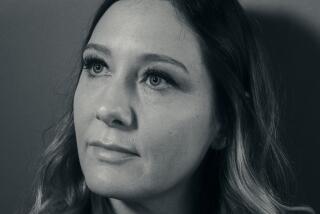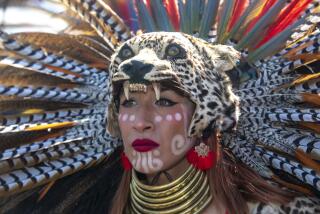DANCE REVIEW : Aboriginal Culture Endures in ‘Dreaming’
- Share via
Covered in white and ocher face and body paint over a thick paste that makes them look like ancient mud figures come to life, dancers of the Northern Australian Territory re-enact a mythic odyssey (“The Wallaby Dreaming”) a world away from the Tanami Desert that is their home.
Accompanied by deep-toned singing and the rhythmic clack of wooden boomerangs, they walk heavily, wearily, with long boomerangs held across their shoulders, re-creating a journey of a thousand miles in only a few minutes.
Representing the oldest continuous living cultures on Earth, they joined two other, unrelated but equally venerable Australian aboriginal groups in “Dancers of the Dreaming” at the Wadsworth Theater on Wednesday. (The performance was originally scheduled to take place outdoors but was relocated due to the cold weather.)
The program was organized to make Americans aware of the great diversity and depth of aboriginal expression--encompassing everything from vibrant animal dances and meditative ceremonies that may date back 50,000 years to ritualizations of comparatively recent events.
For example, the Tiwi Islands contingent from the North West Northern Territory presents “The Bombing of Darwin, 1942,” recalling their role in warning against a Japanese attack plus helping in defense and rescue efforts. Typically, they compress and distill the subject in key sounds and images, combining what we might call a childlike purity of concept with a powerful, adult physicality. This is dance deeply rooted in history and in the landscape, dance central to a society’s sense of itself.
When the dancers of Eastern Arnhem Land, Northern Territory, bound forward to the edge of the sand-covered stage, their stamping feet dig deep, and, in one sequence of restless twisting, crouching, clawing motions from “The Garnbulabula Spirit Beings,” they confront the audience with images of violent death and a sky soaked in blood--not exactly affirming our sentimental notions of indigenous cultures’ “oneness with nature.”
Laced with humor--including the Tiwi group’s parody of bad dancers--the program approaches the audience with the authority and patience of a master teacher, one who recognizes both the importance of the subject and how much a beginning student can be expected to absorb and appreciate. As a model for world dance touring presentations, “Dancers of the Dreaming” is in many, many ways a dream come true.
More to Read
The biggest entertainment stories
Get our big stories about Hollywood, film, television, music, arts, culture and more right in your inbox as soon as they publish.
You may occasionally receive promotional content from the Los Angeles Times.










